Franz Xaver Petter stands as a significant figure in the rich tapestry of 19th-century Austrian art. Born on October 23, 1791, in Lichtental, a suburb of Vienna that was then technically part of Bavaria, and passing away in Vienna on May 11, 1866, Petter dedicated his artistic life primarily to the genre of still life painting. He became particularly renowned for his exquisite depictions of flowers and fruit, securing a lasting reputation within the Biedermeier period and beyond. His work not only captured the aesthetic sensibilities of his time but also reflected a deep engagement with art history and the natural world.
Early Life and Artistic Inclination
Franz Xaver Petter's entry into the world of art was not a foregone conclusion. His father was a skilled porcelain painter, a craft demanding precision and decorative flair. Naturally, the expectation was that young Franz would follow in his father's footsteps, inheriting the family trade. Porcelain painting was a respectable and established profession, particularly in a city like Vienna with its imperial manufactories and aristocratic clientele.
However, the younger Petter harbored different ambitions. While the meticulousness required for porcelain decoration might have provided some foundational discipline, his true passion lay elsewhere. He was drawn irresistibly to the medium of oil painting, attracted by its potential for depth, texture, and luminosity, which differed significantly from the smooth, hard surface of porcelain. This divergence marked an early assertion of his individual artistic path, choosing the canvas over ceramics and setting the stage for a career focused on the easel rather than the kiln.
Academic Foundations in Vienna
Recognizing his burgeoning talent and commitment, Petter pursued formal artistic training. He enrolled at the prestigious Vienna Academy of Fine Arts (Akademie der bildenden Künste Wien), the epicentre of artistic education in the Habsburg Empire. This institution provided him with the technical skills and theoretical knowledge necessary to excel.
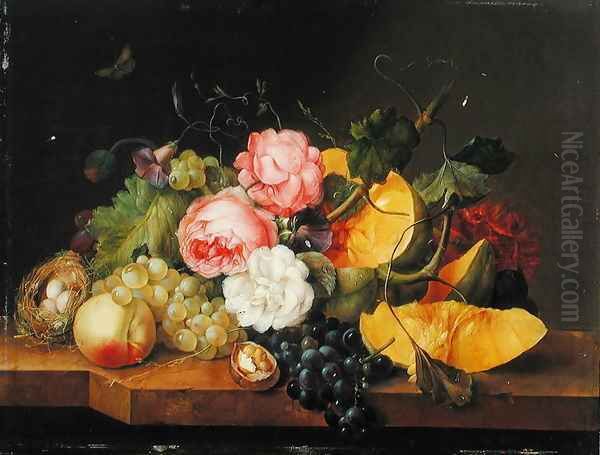
At the Academy, Petter had the distinct advantage of studying under two of the most prominent Viennese flower painters of the preceding generation: Johann Baptist Drechsler (1756-1811) and Sebastian Wegmayr (1776-1857). Drechsler, often considered the founder of the Viennese school of flower painting, had himself revitalized the genre, moving away from purely decorative Rococo styles towards greater naturalism. Wegmayr, Drechsler's student and successor at the Academy, continued this tradition. Studying under these masters immersed Petter in the established Viennese approach to floral depiction, emphasizing botanical accuracy, elegant composition, and refined technique.
The Influence of the Dutch Masters
While Petter absorbed the teachings of his Viennese mentors, his artistic vision extended further back, drawing profound inspiration from the Dutch Golden Age of the 17th century. The source material indicates he was notably responsive to Dutch painting, even suggesting he might have been the first Viennese painter of his generation to seek direct inspiration from these Northern European masters, rather than solely relying on the interpretations passed down through his local teachers.
The legacy of artists like Jan Davidsz. de Heem (1606-1684), known for his opulent and complex still lifes, Rachel Ruysch (1664-1750), celebrated for her dynamic and scientifically accurate floral arrangements, and Jan van Huysum (1682-1749), famed for his luminous colours and incredibly detailed depictions often set against light backgrounds, resonated deeply with Petter. He admired their unparalleled technical skill, their ability to render textures convincingly, and their sophisticated compositional strategies. This engagement with Dutch precedents provided a rich historical foundation upon which Petter would build his own distinct style.
Defining the Petter Style: Technique and Aesthetics
Franz Xaver Petter forged an artistic identity that, while rooted in tradition, possessed unique characteristics. His style is often described as a bridge between the meticulous realism of the Dutch masters and the specific sensibilities of the Viennese Biedermeier era. He specialized primarily in floral still lifes, frequently composing lush bouquets presented in ornate vases or simple containers. These arrangements were often complemented by the inclusion of fruit, adding variety in form, colour, and texture.
Technically, Petter was a master of detail. He rendered the delicate textures of petals, the subtle sheen on leaves, and the glistening surfaces of fruit with remarkable precision. A hallmark of his work, echoing his Dutch predecessors like van Huysum, was the inclusion of minute details that enhanced the sense of realism and vitality. Dewdrops clinging precariously to petals, tiny insects like butterflies, ladybugs, or flies exploring the blossoms – these elements not only demonstrated his virtuoso skill but also added a layer of life and transient beauty to the compositions.
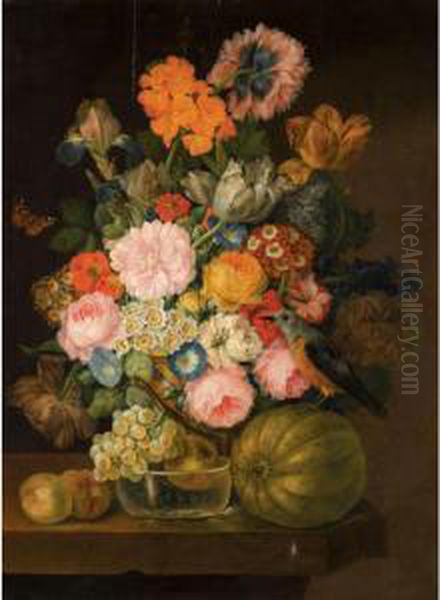
In terms of colour and light, Petter often employed a palette that was somewhat lighter and warmer than that of some of the earlier Dutch masters. His colours could be vibrant and clear, contributing to the overall decorative appeal of his works. He skillfully manipulated light to create a sense of depth and volume, highlighting the forms of the flowers and fruit against often neutral or subtly defined backgrounds. His compositions were typically elegant and balanced, reflecting the Biedermeier preference for harmony, order, and refined aesthetics.
Key Themes and Subjects
The primary focus of Petter's oeuvre was undoubtedly flowers. He depicted a wide variety of species, often combining cultivated garden flowers with wildflowers, showcasing the botanical diversity available to him. Roses, tulips, peonies, carnations, lilies, forget-me-nots, and many others feature prominently in his bouquets. These were not merely decorative arrangements; they often reflected the contemporary interest in botany and horticulture that flourished during the Biedermeier period, particularly among the educated upper classes.
Fruit was another recurring subject, sometimes as the central focus but more often complementing the floral arrangements. Grapes, peaches, plums, pomegranates, and melons added weight, different textures, and rich colours to his compositions. The inclusion of Mediterranean fruits, as noted in descriptions of his 1830 works, suggests an awareness of and access to imported goods, perhaps reflecting Vienna's status as an imperial capital.
While less common, Petter also incorporated landscape elements into some of his still lifes, providing atmospheric backgrounds that contextualized the primary subjects. The occasional inclusion of birds, particularly colourful parrots or parakeets, added an exotic touch and further enlivened the scenes, demonstrating his versatility beyond flora.
Blossoming Career and Academic Role
Petter's talent did not go unnoticed, and he built a successful professional career. As early as 1814, he secured a position as a 'corrector' or assistant instructor at the Academy's flower painting school, indicating his early promise and recognition within the institution where he had trained. This marked the beginning of a long association with art education in Vienna.
A significant advancement came in 1832 when he was appointed Professor at the Manufaktur Zeichenschule (Manufactory Drawing School). This institution was crucial for training artisans and designers for Vienna's various manufacturing industries, including porcelain and textiles – ironically linking back to the profession his father had intended for him. His role here suggests his expertise was valued not just in fine art but also in applied arts, bridging the gap between artistic creation and industrial production.
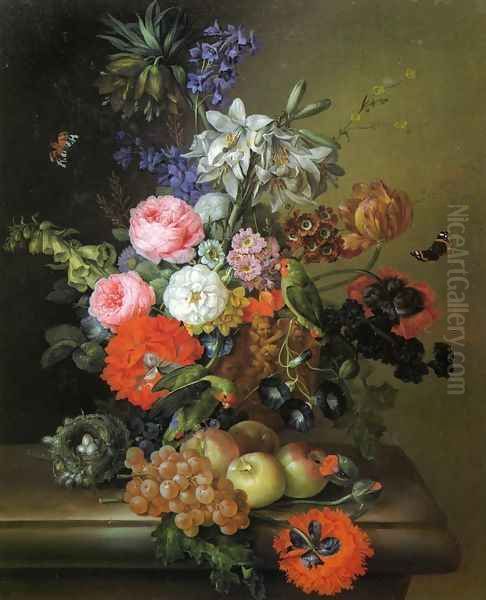
His standing continued to rise, and in 1835, he became an academic advisor and the Director of the Manufaktur Zeichenschule. Holding these positions underscored his authority in the field and his importance within Vienna's artistic and educational infrastructure. He was not just a painter but also an influential figure shaping the training of future artists and designers.
Masterworks and Signature Pieces
Among Petter's most celebrated works are the pair titled Two Flower Still Lifes, painted in 1830. These paintings are often cited as representing a high point in his creative output. They exemplify his mature style, showcasing elaborate bouquets featuring a rich variety of flowers alongside fruits like sun-drenched pomegranates and plums. These works perfectly encapsulate the Biedermeier era's fascination with the natural world, blending scientific observation (in the accurate depiction of species) with artistic sensibility. The source material notes these works reflect the contemporary interest in botany and science prevalent among the Austrian aristocracy.
Another known work, Still Life of Flowers with Daffodils, further demonstrates his skill in capturing the specific character of different flowers and arranging them into harmonious compositions. While many of his works follow the format of bouquets in vases, often placed on stone ledges or tables, the variety within this theme is considerable. The choice of flowers, the type of vase (ranging from simple earthenware to ornate porcelain or glass), the inclusion of complementary elements like fruit, insects, or even bird's nests, all contribute to the unique character of each painting. His works are held in various museums, including the Belvedere in Vienna, and numerous private collections worldwide.
Patronage, Prestige, and the Biedermeier Context
Franz Xaver Petter enjoyed considerable success and recognition during his lifetime. His paintings were highly sought after by the Viennese aristocracy and the increasingly affluent bourgeoisie. The Biedermeier period (roughly 1815-1848) saw a flourishing of domestic culture, and art that celebrated the beauty of nature and was suitable for intimate interior settings was particularly popular. Petter's refined, detailed, and aesthetically pleasing still lifes perfectly met this demand.
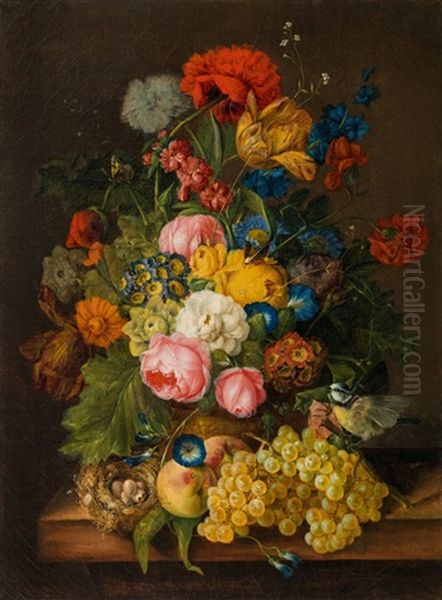
His patrons appreciated the decorative quality of his work, its technical brilliance, and its alignment with Biedermeier values: an appreciation for nature, domesticity, order, and quiet contemplation. His ability to render flowers and fruit with such lifelike precision appealed to the era's growing interest in the natural sciences. Owning a Petter painting was a mark of taste and sophistication. His works commanded respectable prices and found their way into important collections, including potentially imperial ones, solidifying his status as one of Vienna's leading painters in his chosen genre.
His success can be contextualized alongside other prominent Biedermeier artists. While painters like Friedrich von Amerling (1803-1887) excelled in elegant portraiture and Peter Fendi (1796-1842) captured charming genre scenes of everyday life, Petter carved out his niche as the preeminent master of floral still life, rivaled perhaps only by the versatile Ferdinand Georg Waldmüller (1793-1865), who also produced exquisite flower paintings alongside his portraits and landscapes.
Teaching and Enduring Legacy
Petter's influence extended beyond his own canvases through his long career as an educator. As a professor at the Vienna Academy and Director of the Manufaktur Zeichenschule, he played a direct role in training the next generation of artists. His dedication to the principles of careful observation, technical refinement, and elegant composition undoubtedly shaped the development of many students.
One of his most notable pupils was Archduchess Maria Hendrika of Austria (1836-1902), who later became Queen of the Belgians through her marriage to King Leopold II. That a member of the imperial family sought instruction from him speaks volumes about his reputation and pedagogical skill.
His artistic legacy was also carried on within his own family. His son, Theodor Petter (1822-1872), followed in his father's footsteps and became a recognized flower painter in his own right, continuing the family tradition and contributing to the Viennese still life school. Franz Xaver Petter's impact, therefore, was twofold: through his own impressive body of work and through the knowledge and skills he imparted to his students, ensuring the continuation of the floral painting tradition in Vienna. His connection with the botanist and illustrator Nicolaus von Jacquin (1727-1817), mentioned in the source material, also highlights the interdisciplinary context of his work, linking fine art with scientific illustration.
Petter and His Contemporaries
Franz Xaver Petter worked during a vibrant period in Viennese art history. He was a contemporary of several significant Austrian artists. His relationship with his former teacher, Sebastian Wegmayr, evolved into one of colleagues practicing within the same specialized genre. Both contributed significantly to the Biedermeier floral painting tradition.
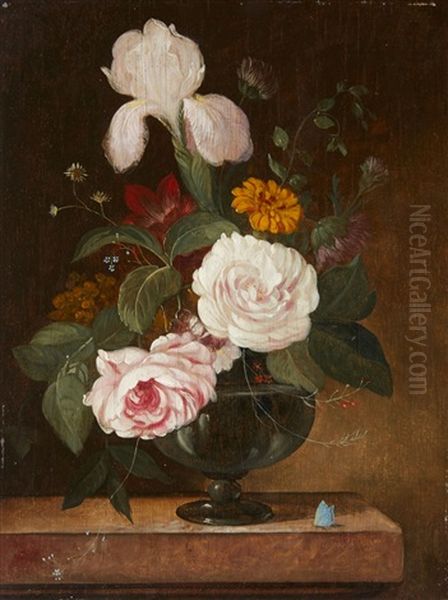
Ferdinand Georg Waldmüller, arguably the most famous Austrian painter of the Biedermeier era, was almost an exact contemporary. While Waldmüller's range was broader, encompassing landscape, portraiture, and genre scenes executed with a remarkable sense of realism and light, his flower paintings are considered masterpieces in their own right. Comparing Petter and Waldmüller reveals different facets of Biedermeier still life: Petter often focused on lush abundance and intricate detail within established compositional frameworks, while Waldmüller sometimes brought a brighter, almost plein-air sensibility even to his floral works.
Other contemporaries help paint the picture of the artistic milieu. Thomas Ender (1793-1875) was renowned for his detailed landscape watercolours, often documenting distant lands. Johann Peter Krafft (1780-1856) was a leading figure in historical and portrait painting. While their genres differed, these artists collectively defined the artistic landscape of Vienna during Petter's active years. Petter's dedicated focus on still life allowed him to achieve a particular depth and mastery within that field, complementing the diverse talents of his peers.
Later Life and Conclusion
Franz Xaver Petter remained active as a painter and likely continued his teaching duties for many years. He lived through a period of significant change in Vienna, witnessing the Biedermeier era give way to the more turbulent times leading up to and following the revolutions of 1848, and eventually the beginnings of the grand Ringstrasse era. He passed away in Vienna in 1866 at the age of 74.
In summary, Franz Xaver Petter was a pivotal figure in 19th-century Austrian art. He masterfully synthesized the rich tradition of Dutch Golden Age still life with the specific aesthetic preferences of Viennese Biedermeier culture. His paintings are celebrated for their meticulous detail, vibrant yet harmonious colours, elegant compositions, and sensitive portrayal of the natural world. Through his popular works and his influential role as an educator, Petter not only achieved considerable success during his lifetime but also left a lasting legacy, securing his place as one of Vienna's most accomplished and cherished masters of floral and fruit still life painting. His art continues to be admired for its beauty, technical excellence, and evocative capture of a bygone era's fascination with nature's bounty.